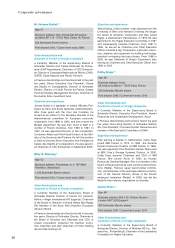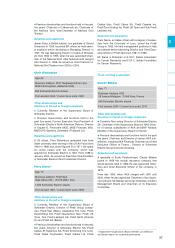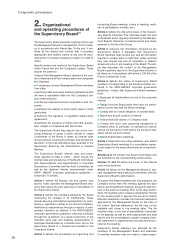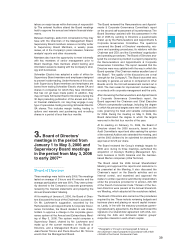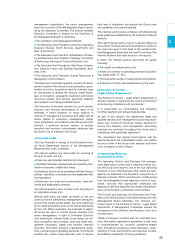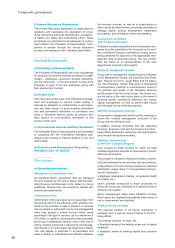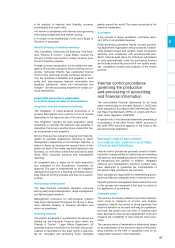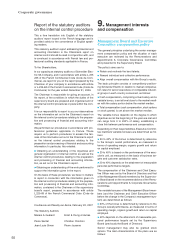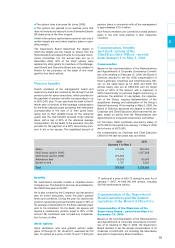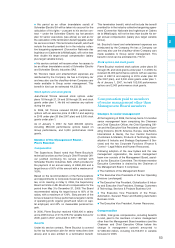APC 2006 Annual Report Download - page 48
Download and view the complete annual report
Please find page 48 of the 2006 APC annual report below. You can navigate through the pages in the report by either clicking on the pages listed below, or by using the keyword search tool below to find specific information within the annual report.
f) Human Resources Department
The Human Resources department is responsible for
deploying and overseeing the application of proce-
dures concerning employee development, occupation-
al health and safety and professional ethics. These
procedures are presented to all employees in a docu-
ment entitled
"Our Principles of Responsibility".
Com-
pliance is verified through the annual evaluation
process and tracking of new2indicators (see below).
Internal benchmarks
a) Principles of Responsibility
The Principles of Responsibility are a set of guidelines
for decisions and actions that have an impact on stake-
holders – employees, customers, vendors, sharehold-
ers, the community – or the environment. A copy of the
Principles is given to all new employees along with
their employment contract.
b) Insider Code
This code sets out the rules to be followed by manage-
ment and employees to prevent insider trading. It
imposes an obligation of confidentiality on all employ-
ees who have access to price-sensitive information
and sets permanent restrictions on purchases and
sales of Schneider Electric shares by persons who
have access to price-sensitive information in the
course of their work.
c) International Internal Auditing Standards
The Schneider Electric internal auditors are committed
to complying with the international standards pub-
lished by the Institute of Internal Auditors (I.I.A.) and
other bodies.
d) Statutory and Management Reporting
Principles (see "C" below)
Procedures
a) Operating procedures
Management of operational risks
As explained above, operational risks are managed
first and foremost by the units in liaison with the Oper-
ating Divisions and Business Units, based on Group
guidelines. General risks are covered by specific pro-
cedures described below.
Commitment limits
Commitment limits have been set for executives from
Group level down to the individual units, whereby con-
tracts for the purchase or sale of products or services
may be signed or authorized only by line management
when they exceed a certain amount which varies
according to the type of contract, up to a maximum of
10 million. In addition, all transactions that may affect
the Group’s fundamental interests, due to their size or
nature, must be authorized in advance by the Manage-
ment Board or, in some cases, the Supervisory Board.
This rule applies in particular to all purchases and
sales of shares in subsidiaries and affiliates whatever
the amounts involved, as well as to subscriptions to
share issues by these entities, purchases and sales of
strategic assets, product development, trademarks
and patents, and off-balance sheet commitments.
Acquisitions Committee,
New Products Committee
Proposed business acquisitions and development pro-
grams must be submitted to the Acquisitions Commit-
tee or the New Products Committee for review, prior to
being presented for approval at the appropriate man-
agement level as described above. The two commit-
tees are made up of representatives of the main
departments involved in the projects.
Quarterly management reviews
Group senior management (comprising the Chairman
of the Management Board, the Executive Vice-Presi-
dent, Finance & Control - Legal Affairs and the Execu-
tive Vice-President, Human Resources & Managerial
Communication) performs a comprehensive review of
the activities and results of the Operating Divisions
and Business Units four times a year. The review cov-
ers the status of the main action plans in the areas of
business growth, operational efficiency and human
capital management, as well as year-to-date results
and forecasts for the remaining quarters.
Monthly management reporting
Group senior management holds monthly meetings to
review the monthly management accounts of the
Group and the individual units.
In addition, financial controllers from the Operating
Divisions, Business Units and the Finance & Control -
Legal Affairs department review the units’ performance
and principal transactions monthly.
Tracking of priorities set
by the new2Company Program
new2focuses on three priorities for which we have
identified significant potential for improvement: growth,
efficiency and people.
The program’s indicators, measured monthly, concern:
Growth achieved by new activities and new products.
The efficiency of such critical processes as customer
satisfaction, supply chain, IT and purchasing and pro-
duction localization.
Employee development (training, occupational health
and safety, etc.).
new2’s priorities correspond to major processes for
which the Group has committed to a maximum level of
efficiency and quality.
Senior management tracks these indicators monthly.
Action plans are deployed immediately when areas of
risk or improvement are identified.
Financial review meetings
The financial position of all Group companies is
reviewed once a year by Group Finance & Control -
Legal Affairs.
The process includes, for each unit:
Analytical review of the balance sheet and of capital
employed.
Analytical review of working capital and customer
credit.
Corporate governance
46


